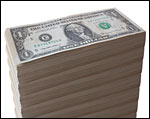
Will global warming eventually cost the world’s economy $12 trillion? I’ve got no clue. I mean, even the specialists who’ve studied the economic impacts of climate change have no real idea. The latest figure is just their best guess.
But this much is clear: no matter whether this estimate is on the mark, the idea that we should tally the cost of “business as usual” — i.e., letting climate change run amok — is exactly the right framework for thinking about the issue.
Look, I can’t count the times I’ve read a claim to this effect: “Even if climate change is really happening, the cost of fixing it is just too great.”
That’s just dopey.
I mean, sure, painting my house is really expensive. But not painting my house is even more expensive — I save on paint but I eventually pay much, much more to repair water damage. Pretending that there’s some sort of third choice — like, neither painting nor suffering water damage — is magical thinking at best, delusional at worst.
So sure, fighting global warming may require us to spend some money (though I anticipate the early stages will probably save money, while making the economy more resilient — which is a story for another day). But letting global warming run amok will be expensive too. Tallying up the cost of fighting global warming, without a serious and sober look at the cost of doing nothing, is the sort of basic error that ought to get you laughed out of Accounting 101.
Which is why studies that look at the cost of global warming’s “business as usual” scenarios are so important. They make it much easier to see the full consequences of climate policy choices — and much harder for global warming skeptics to pretend that all the costs of climate change wind up on one side of the ledger.


